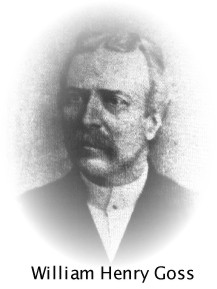W.H. Goss (1833-1906)

"Goss China" is the term used to refer to the products of the Falcon Pottery, situated in Stoke on Trent, of Mr. William Henry Goss.
William Henry Goss was born in London in 1833, the son of Richard and Sophia Goss. He studied at the School of Design in Somerset House, London.
In 1857 Goss came to work at the pottery company of W. T. Copeland as chief artist. A disagreement led to his setting up in business on his own in 1858 at the nearby small Cock Works in John Street (now Leese Street), off Liverpool Road, Stoke.
He continued to produce similar wares in competition with Copeland and developed processes for making jewelled vases and scent bottles in highly elaborate designs. Early in his career he entered into partnership with a Mr. Peake, a terracotta roofing tile manufacturer, and during this short period produced a range of terracotta water coolers, spill vases, tobacco jars and other wares. This partnership lasted for only about a year and they soon went their own ways.
In the early 1880's William's eldest son, Adolphus, joined the firm. He had been raised in a home adorned with his father's collection of antiques. In those days an antique was a Greek or Roman pot and William was a keen antiquarian. As a child Adolphus was encouraged by his father to take an interest in heraldry and he was soon to suggest to his father that the company take advantage of the new niche market of seaside souvenir collecting by producing miniature copies of Greek and Roman pots and vases decorated with the coat of arms of coastal towns to be sold as "seaside souvenirs".
This caught on in a big way and by the turn of the century had become a collecting craze. From seaside resorts virtually every town and city in the land now had its arms produced and sold by a Goss appointed agent.
It is believed that, in 1910, some 95% of homes in Britain had some "Crested china" on the mantelpiece, sideboard or whatnot.
In addition to heraldic arms, Goss china may be found decorated with multichrome or monochrome transfer prints, commemorative designs, Regimental and Battleship insignia, flowers, seaweed, ancient armour, children's nursery designs and a host of other attractive decorations. The factory also produced a range of miniature houses and cottages all being faithful reproductions of actual buildings. These have become highly collectable and the scarcer ones now command substantial prices.
Other factories in Stoke quickly noted the commercial success of the Goss range of products and "jumped on the band wagon", producing their own range of similar wares, generally of inferior quality although a number of companies, including Arcadian, Willow, Grafton and Shelley produced quality wares and are now collected, quite rightly, in their own right.
After the Great War the interest in heraldic porcelain began to wane and in 1929 the Goss family sold out to a competitor who continued to use the highly respected Goss name to market inferior ware. Despite this, dedicated Goss collectors still regard any piece of china or pottery carrying the Goss trademark as genuine Goss. The use of the trademark fell into disuse after 1938.
In the 1950's a few people began to collect these little pots once again and this has now grown into a fascinating collecting hobby for thousands of people.
Such is the respect now given to these pieces that all the leading auction houses, including Sotherby's, Christies and Phillips regularly include them in their sales and rarer items can command prices running into thousands of pounds.